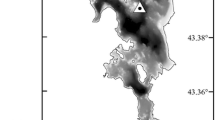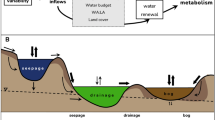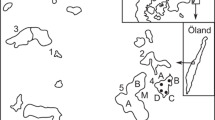Abstract
Previous studies have used sondes to measure diel changes in dissolved oxygen and thereby estimate gross primary production (GPP), ecosystem respiration (R), and net ecosystem production (NEP). Most of these studies estimate rates for the surface layer and require knowing the depth of the mixed layer (Zmix), which is usually determined from discrete daily or weekly temperature profiles. However, Zmix is dynamic, as the thermal structure of lakes may change at scales of minutes rather than days or weeks. We studied two thermally stratified lakes that exhibited intermittent microstratification in the mixed layer. We combined sonde-based estimates of metabolism with high-frequency measurements of stratification using thermistor chains to determine how the short-term dynamics of stratification affect metabolic rates. We calculated estimates of metabolism using time series of Zmix measured at seasonal, weekly, daily, and 5-min intervals. Areal rates of GPP and R were up to 24 and 29% less, respectively, using the 5-min measurements of Zmix rather than weekly Zmix, while NEP was not significantly different. These reduced areal rates are mostly the consequence of the reduction in the depth of the mixed layer. Microstratification occurred frequently in both lakes and affected volumetric rates in one lake where R was significantly lower, NEP was significantly higher, and GPP was marginally lower compared to days without microstratification. Hence, microstratification not only affects the depth of the mixed layer, but also alters the processes that influence photosynthesis and respiration. Future studies should consider microstratification and possibly employ multiple sondes with thermistor chains that enable integrating metabolic rates to a specific depth, rather than assuming a stable upper mixed layer as the basis for calculations.





Similar content being viewed by others
References
Åberg J, Jansson M, Jonsson A (2010) Importance of water temperature and thermal stratification dynamics for temporal variation of surface water CO2 in a boreal lake. J Geophys Res 115:G02024. doi:10.1029/2009JG001085
Bott TL, Brock JT, Dunn CS, Naiman RJ, Ovink RW, Peterson RC (1985) Benthic community metabolism in four temperate stream systems: an inter-biome comparison and evaluation of the river continuum concept. Hydrobiologia 123:3–45
Box GEP (1954) Some theorems on quadratic forms applied in the study of analysis of variance problems, II. Effects of inequality of variance and of correlation between errors in the two-way classification. Ann Math Stat 25:484–498
Caraco NF, Cole JJ (2002) Contrasting impacts of a native and alien macrophyte on dissolved oxygen in a large river. Ecol Appl 12:1496–1509
Carpenter SR, Kitchell JF (1993) The trophic cascade in lakes. Cambridge University Press, London
Cole JJ, Caraco NF (1998) Atmospheric exchange of carbon dioxide in a low-wind oligotrophic lake measured by the addition of SF6. Limnol Oceanogr 43:647–656
Cole JJ, Pace ML, Carpenter SR, Kitchell JF (2000) Persistence of net heterotrophy in lakes during nutrient addition and food web manipulations. Limnol Oceanogr 45:1718–1730
Coloso JJ, Cole JJ, Hanson PC, Pace ML (2008) Depth-integrated, continuous estimates of metabolism in a clear-water lake. Can J Fish Aquat Sci 65:712–722
Eckert WJ, Imberger J, Saggio A (2002) Biogeochemical response to physical forcing in the water column of a warm monomictic lake. Biogeochemistry 61:291–307
Fee EJ, Hecky RE, Kasian SEM, Cruikshank DR (1996) Effects of lake size, water clarity, and climatic variability on mixing depths in Canadian Shield lakes. Limnol Oceanogr 41:912–920
Gelda RK, Effler SW (2002) Metabolic rate estimates for a eutrophic lake from diel dissolved oxygen signals. Hydrobiologia 485:51–66
Hagerthey SE, Cole JJ, Kilbane D (2010) Aquatic metabolism in the Everglades: dominance of water column heterotrophy. Limnol Oceanogr 55:653–666
Hanson PC, Bade DL, Carpenter SR, Kratz TK (2003) Lake metabolism: relationships with dissolved organic carbon and phosphorus. Limnol Oceanogr 48:1112–1119
Hanson PC, Carpenter SR, Kimura N, Chin W, Cornelius SP, Kratz TK (2008) Evaluation of metabolism models for free-water dissolved oxygen methods in lakes. Limnol Oceanogr Methods 6:454–465
Holtgrieve GW, Schindler DE, Branch TA, A’mara ZT (2010) Simultaneous quantification of aquatic ecosystem metabolism and reaeration using a Bayesian statistical model of oxygen dynamics. Limnol Oceanogr 55:1047–1063
Imberger J (1985) The diurnal mixed layer. Limnol Oceanogr 30:737–770
Ishikawa T, Tanaka M (1993) Diurnal stratification and its effects on wind-induced currents and water qualities in Lake Kasumigaura, Japan. J Hydraulic Res 31:307–322
Jahne B, Munnich KO, Bosinger R, Dutzi A, Huber W, Libner P (1987) On the parameters influencing air–water gas-exchange. J Geophys Res Oceans 92:1937–1949
Kalff J (2002) Limnology: inland water ecosystems. Prentice-Hall, USA
Knauss JA (1997) Introduction to physical oceanography, 2nd edn. Prentice-Hall, USA
Lauster GH, Hanson PC, Kratz TK (2006) Gross primary production and respiration differences among littoral and pelagic habitats in northern Wisconsin lakes. Can J Fish Aquat Sci 63:1130–1141
Lovett G, Cole J, Pace M (2006) Is net ecosystem production equal to ecosystem carbon accumulation? Ecosystems 9:152–155
MacIntyre S (1993) Vertical mixing in a shallow, eutrophic lake—possible consequences for the light climate of phytoplankton. Limnol Oceanogr 38:798–817
MacIntyre S, Wanninkhof R, Chanton JP (1995) Trace gas exchange across the air-water interface in freshwater and coastal marine environments. In: Matson PA, Harriss RC (eds) Methods in ecology biogenic trace gasses: measuring emissions from soil and water. Blackwell Science, Oxford, pp 52–97
MacIntyre S, Flynn KM, Jellison R, Romero JR (1999) Boundary mixing and nutrient fluxes in Mono Lake, California. Limnol Oceanogr 44:512–529
MacIntyre S, Sickman JO, Goldthwait SA, Kling GW (2006) Physical pathways of nutrient supply in a small, ultraoligotrophic arctic lake during summer stratification. Limnol Oceanogr 51:1107–1124
Marra J (1978a) Phytoplankton photosynthetic response to vertical movement in a mixed layer. Mar Biol 46:203–208
Marra J (1978b) Effect of short-term variations in light intensity on photosynthesis of a marine phytoplankter: a laboratory simulation study. Mar Biol 46:191–202
McIntire CD, Garrison RL, Phinney HK, Warren CE (1964) Primary production in laboratory streams. Limnol Oceanogr 9:92–102
Odum HT (1956) Primary production in flowing waters. Limnol Oceanogr 1:102–117
Pace ML, Prairie YT (2005) Respiration in lakes. In: del Giorgio PA, Williams PJLB (eds) Respiration in aquatic ecosystems. Oxford University Press, USA, pp 103–121
Staehr P, Sand-Jensen K (2007) Temporal dynamics and regulation of lake metabolism. Limnol Oceanogr 52:108–120
Staehr PA, Sand-Jensen K, Raun AL, Nilsson B, Kidmosec J (2010) Drivers of metabolism and net heterotrophy in contrasting lakes. Limnol Oceanogr 55:817–830
Vadeboncoeur Y, Vander Zanden MJ, Lodge DM (2002) Putting the lake back together: reintegrating benthic pathways into lake food web models. Bioscience 52:44–54
Vadeboncoeur Y, Peterson G, Vander Zanden MJ, Kalff J (2008) Benthic algal production across lake size gradients: interactions among morphometry, nutrients, and light. Ecology 89:2542–2552
Van de Bogert MC, Carpenter SR, Cole JJ, Pace ML (2007) Assessing pelagic and benthic metabolism using free water measurements. Limnol Oceanogr Methods 5:145–155
Acknowledgments
We thank Gary Belovsky, Michael Cramer, and Heidi Mahon of the University of Notre Dame Environmental Research Center for facilitating this research. We greatly appreciate the efforts of Laura Smith for assisting with the sondes and thermistor chains. Karen McGlathery, Matt Reidenbach, and two anonymous reviewers provided suggestions on earlier versions of this manuscript. This work was funded by a grant from the National Science Foundation (DEB-0829583).
Author information
Authors and Affiliations
Corresponding author
Rights and permissions
About this article
Cite this article
Coloso, J.J., Cole, J.J. & Pace, M.L. Short-term variation in thermal stratification complicates estimation of lake metabolism. Aquat Sci 73, 305–315 (2011). https://doi.org/10.1007/s00027-010-0177-0
Received:
Accepted:
Published:
Issue Date:
DOI: https://doi.org/10.1007/s00027-010-0177-0




